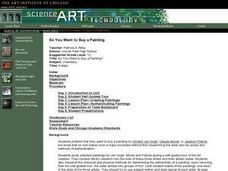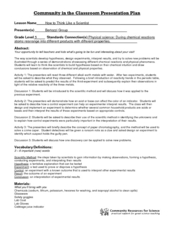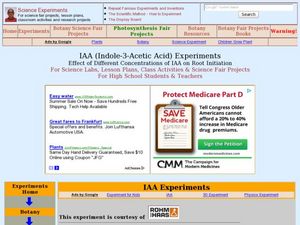Curated OER
Crime Scene Documentation
Students become forensic investigators. In this crime scene lesson, students go to the science lab which is the "scene of the crime." They collect evidence such as fingerprints, "blood" evidence, chromatography, footprints, and more.
Beyond Benign
Gelin’: Gel Electrophoresis Simulation
Take a look at a DNA fingerprint. Scholars run a gel electrophoresis simulation to examine the DNA of potential father cats in the eighth installment of an 18-part series. The lesson continues the series that explores DNA and its...
Curated OER
Separation of Unknowns in a Liquid
Learners identify the different components of a given sample using chromatography. In this chemistry lesson plan, students compare paper and column chromatography. They collect data and construct data tables.
Curated OER
Plant Pigment Chemistry
Young scholars discover the roles of pigments present in leaves. They extract and isolate pigments present in autumn leaves using a thin layer chromatography. Very nice lesson and lab!
Curated OER
Science: Pigments and Photosynthesis
Students explore the process of photosynthesis by identifying chloroplasts and chlorophyll pigments. In a demonstration, they observe a demonstration connecting pigments with sunlight conversion into energy. Using paper chromatography,...
Curated OER
The Game is Afoot - A Study of Sherlock Holmes
Mystery is an exciting genre for young readers to investigate. The plots are so intriguing! Here is a series of lessons featuring Sherlock Holmes stories that invite learners to enter the world of the mystery genre. Based on what they...
Curated OER
Photosynthesis
Students assess and experiment with the role of plant pigments in photosynthesis. They relate the basic principles of photosynthesis utilizing paper chromatography to evaluate a hypothesis regarding plant pigments as well as the role of...
Curated OER
Characterizing Drosophila Mutants
Learners investigate wild-type and several mutant varieties of Drosophila melanogaster, which are characterized and distinguished according to pteridine pigments. They discoverthat paper chromatography of the wild-type Drosophila results...
Curated OER
So You Want to Buy a Painting
Twelfth graders research physical and chemical methods used in authenticating paintings (e.g., ultraviolet fluorescence and spectroscopy, infrared spectroscopy and reflectography, X-ray diffraction, microscopy, pigment analysis, and gas...
Curated OER
Does Dye Die...? : Foreign Chemicals In Our Environment
Young scholars work as scientists to simulate testing on soil, plants, and water for foreign chemicals through this series of experiments.
Curated OER
Investigating The Mysteries Of Third Grade
Third graders use logic and knowledge of mathematics facts to solve problems. They see that pigments can be broken down into separate colors. Pupils recognize the capacity of water to move upward and measure the height water travels up...
Curated OER
How to Think Like a Scientist
Fifth graders study the scientific method and understand how to apply it. In this "thinking like a scientist" lesson students complete several activities.
Curated OER
Molecular Approaches to Evolution
High schoolers examine the molecular studies of organisms that have led to a new era in their understanding of speciation and evolutionary relationships. Students study the allelic frequency of genes controlling specific molecules and...
Curated OER
DNA Fingerprinting
Students discuss DNA Fingerprinting and gel electrophoresis before participating in a crime solving activity. Students simulate their DNA using adding tape and complete the steps necessary to do a gel electrophoresis. They discuss the...
Curated OER
Auxin: Indole-3-Acetic Acid (AAA), A Hormone with Diverse Effects: Synthesis and Applications
Students synthesize Indole-3-Acetic acid from 3-indolylacetonitrile. In this biochemistry lesson, students determine the effect of different concentrations of IAA on lima beans. They explain how hormones help in plant development.
Curated OER
Does Dye Die? Foreign Chemicals in Our Environment
Students conduct an experiment to observe photolysis in the lab. In this chemistry lesson, students explain the mechanism behind photolysis. They test the impact of a non-toxic marker to plant metabolism.
Curated OER
Molecular Evolution in Plants
Learners examine chlorophylls. They explore the absorbing pigments in a variety of plants. Through activities, students determine spectrophotometrically. They compare plant proteins from the family Brassicace to assess the level of...
Curated OER
Relationships and Biodiversity
Young scholars examine diversity on the planet and the differences within a species. In this investigative lesson students complete a lab that allows young scholars to better understand the relatedness between plants.
Curated OER
Isolation of Synthetic Chemicals from Plant Leaves
Young scholars isolate and identify a dye, which represents a synthetic pesticide, from plants.
Curated OER
Color Burst
Students gain experience in asking questions and conducting inquiry by exploring the separation of colors in water and other solvents; to communicate and share findings of student investigations.
Curated OER
Molecular Approaches to Evolution
Students are introduced to working with molecular data. The first activity does both simulated and original data are used to compare amino acid, protein or DNA differences to construct phylogenetic trees or cladograms. These activities...
Other popular searches
- Column Chromatography
- Paper Chromatography
- Chromatography Lab
- Chromatography Forensics
- Chlorophyll Chromatography
- Ink Chromatography
- Plant Chromatography
- Crime Scene Chromatography
- Thin Layer Chromatography
- Chromatography Pigment
- Gas Chromatography
- Leaf Chromatography






















